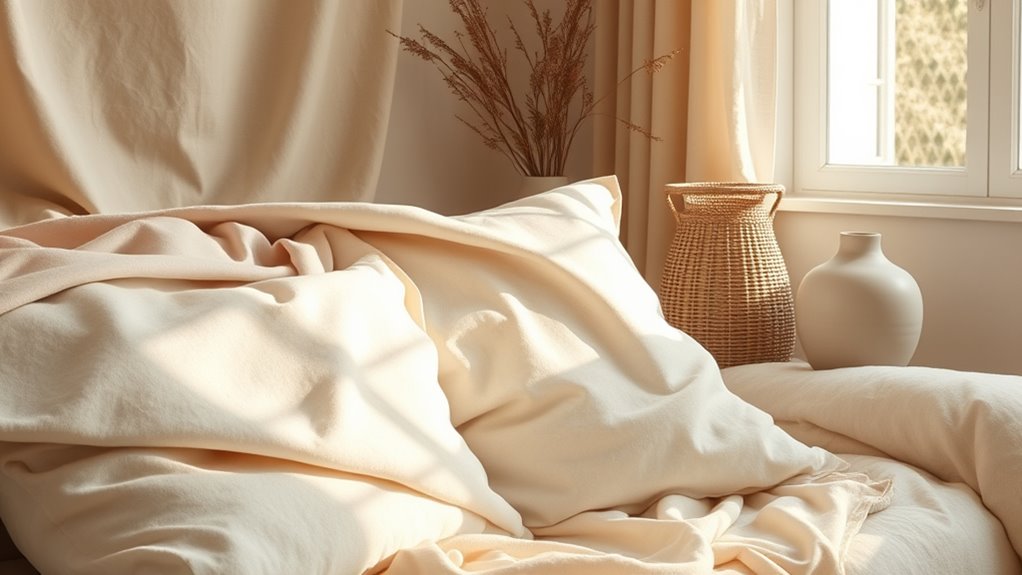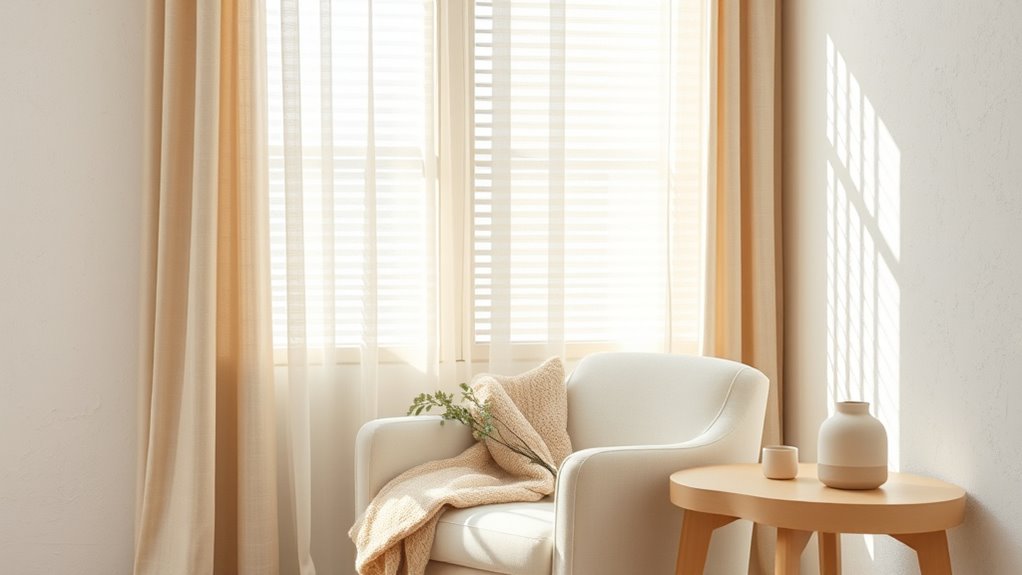To create a calming space with neutral beiges and warm whites, start by layering different textures like soft linen cushions, plush rugs, and knitted throws to add depth. Use warm-toned lighting and natural light filtering through sheer curtains to enhance the cozy atmosphere. Balance smooth fabrics with chunky knits and incorporate subtle tonal variations for visual interest. Keep exploring these subtle techniques to craft a truly serene sanctuary.
Key Takeaways
- Combine different shades of beige and warm white to add subtle depth and prevent flatness.
- Incorporate varied textures like linen, wool, and plush fabrics for tactile interest.
- Use soft, layered lighting with dimmable fixtures and candles to enhance warmth.
- Maximize natural light with sheer curtains to create an airy, calming atmosphere.
- Layer textiles and lighting thoughtfully to craft a balanced, serene retreat.

Creating a calming space often begins with the right color palette, and layering neutral beiges with warm whites can achieve that soothing effect. But color alone isn’t enough; how you incorporate textile textures and lighting techniques plays a crucial role in turning a simple palette into a tranquil retreat. When you choose textiles, think about variety—knitted throws, soft linen cushions, and plush rugs add depth and tactile interest. These textures invite touch and create a cozy environment, making the space feel layered and thoughtfully curated. Opt for fabrics in shades of beige and white, but vary their textures to avoid flatness. For example, pair a smooth silk pillow with a chunky knit blanket, and you’ll notice how the different tactile qualities enhance the overall serenity of the room. Incorporating natural materials such as linen and cotton can further amplify the authentic farmhouse aesthetic and promote comfort. Lighting techniques are equally essential in shaping the calming atmosphere. Soft, ambient lighting is your best friend here. Instead of harsh overhead lights, use table lamps with warm-toned bulbs, floor lamps with dimming options, or even candles to create a gentle glow. Dimming switches allow you to adjust the light intensity based on your mood or time of day, fostering a sense of relaxation. Natural light also plays a key role—maximize it by choosing window treatments that diffuse sunlight, such as sheer curtains or light-filtering blinds. This creates a warm, inviting environment without overpowering brightness. When you layer lighting sources, you add visual interest and depth, which helps the space feel more welcoming and calming. Incorporating textile textures and lighting techniques isn’t just about aesthetics; it’s about crafting an environment that encourages relaxation. When textiles are soft and inviting, they become physical touchpoints that soothe your senses. Meanwhile, well-planned lighting techniques set the mood, making your space feel warm, peaceful, and harmonious. You may find that adjusting these elements over time allows you to fine-tune your sanctuary—adding a chunky throw here, switching to warmer light bulbs there—until it resonates perfectly with your sense of calm. The key is balance and intentionality: combining textures and lighting thoughtfully ensures your space remains serene and inviting, a true reflection of your desire for peace. Paying attention to interior decor elements such as textiles and lighting can transform your room into a peaceful retreat that nurtures your well-being every day.
Frequently Asked Questions
How Can I Incorporate Accent Colors With Neutral Beiges and Whites?
To incorporate accent colors with neutral beiges and whites, you can use complementary color schemes to add vibrancy without overwhelming the calm. Choose bold accent pieces like pillows, artwork, or rugs in shades that contrast nicely, such as navy or emerald green. These pops of color create visual interest while maintaining the soothing atmosphere. Keep the neutral base intact, and let your accent pieces bring personality and depth to the space.
What Lighting Enhances the Calming Effect of Neutral Layering?
Imagine transforming your space into a sanctuary—lighting plays a vital role. Natural daylight enhances the soft, calming tones of neutrals, creating a fresh, airy feel. Meanwhile, warm artificial lighting adds cozy depth, making your room inviting without overwhelming it. Combining both allows you to tailor the mood, ensuring your space remains serene and balanced. You’ll discover that the right lighting elevates your neutral palette, turning calm into an everyday experience.
Which Textures Work Best With Beige and White Palettes?
When choosing textures for a beige and white palette, focus on creating subtle textural contrast with your fabric choices. Soft linen or cotton adds a relaxed feel, while woven or textured fabrics like boucle or chenille bring warmth and depth. Incorporate natural materials such as rattan or wood for visual interest. These fabric choices enhance the calming atmosphere, making your space feel cozy yet sophisticated.
How Do I Maintain Color Consistency Across Different Rooms?
Oh, the challenge of maintaining color consistency across rooms—who would’ve thought? To master this, you’ll want to focus on precise color matching by selecting the same paint brand and color code. Use a consistent paint finish, like matte or eggshell, for uniformity. Keep sample swatches handy, and always test in different lighting. This way, your beige and white palette stays harmonious, no matter which room you’re in.
Can Layering Neutrals Suit a Modern or Traditional Style?
Layering neutrals can beautifully suit both modern and traditional styles, offering timeless elegance and design versatility. You’ll find that neutral tones create a seamless, sophisticated look that adapts to your decor choices. In modern spaces, they add sleek simplicity, while in traditional settings, they enhance warmth and charm. By carefully selecting and layering neutrals, you craft a balanced, harmonious environment that feels both fresh and timeless, regardless of your style preference.
Conclusion
By layering neutral beiges and warm whites, you create a calming, inviting space that promotes relaxation. Studies show that neutral tones can reduce stress levels by up to 20%, making your home not just beautiful but also soothing. So, embrace these soft hues and layered textures to craft a peaceful retreat. With just a few thoughtful touches, you’ll turn your space into a tranquil haven you’ll love coming home to every day.









